Bioelectronics
Bring your bioelectronics printing in-house
Bioelectronics is a multidisciplinary field that merges biology, computer engineering, materials science, chemistry, and electrical engineering to create devices that monitor or control biological processes. These innovative devices integrate electronic components like sensors and circuits with biological systems, including cells, tissues, and organs.
Bioelectronic technology spans a range of applications, including biomedical sensors, energy storage and harvesting devices, implantables, and soft robotics [1]. It supports drug delivery, glucose monitoring, treatment, neuroprosthetics for restoring lost functions.


- Medical
- Prosthetics
- Pharmaceutical
- Consumer electronics
- Silver-based inks
- Copper-based inks
- Carbon-based inks
- Gold-based inks
- Polymer-based dielectric inks
- Ceramic-based dielectric inks
- Polydimethylsiloxane (PDMS)
- Polycarbonate (PC)
- Polyethylene terephthalate (PET)
- Hydrogels
- Silicon
- Fabric
Our white papers

Printing ECG Electrodes with Biocompatible Gold Ink on TPU
This project demonstrates how we validated the effectiveness of printing ECG electrodes on TPU using biocompatible gold ink and stretchable silver ink.